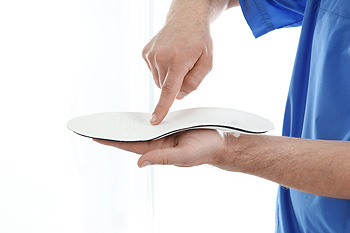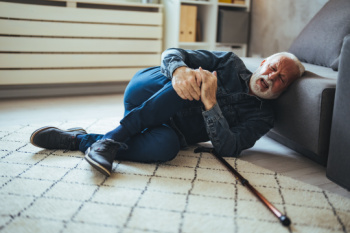
(616) 846-3400
Fax: (616) 846-3406

(616) 846-3400
Fax: (616) 846-3406

 Children’s footwear plays a significant role in the development of their feet and the way they walk, known as their gait. Shoes that are ill-fitted or lack proper support may lead to many foot conditions, such as flat feet, hammertoe, or even issues with posture and balance. Investing in properly fitting shoes helps children's feet grow correctly, supports a natural gait, and aids in maintaining good body alignment. Shoes that are too tight or too loose, can lead to discomfort, or possible long-term health issues. Children’s feet are still developing, and their bones, muscles, and ligaments are not fully formed. Wearing unsupportive footwear during these stages of life can cause permanent damage and affect their ability to participate in daily activities. Quality shoes should have a flexible sole to allow natural movement, plenty of room for the toes, and good arch support to encourage proper foot mechanics. If any issues regarding your child’s foot health arise, it is suggested to visit a podiatrist for a thorough exam and appropriate treatment.
Children’s footwear plays a significant role in the development of their feet and the way they walk, known as their gait. Shoes that are ill-fitted or lack proper support may lead to many foot conditions, such as flat feet, hammertoe, or even issues with posture and balance. Investing in properly fitting shoes helps children's feet grow correctly, supports a natural gait, and aids in maintaining good body alignment. Shoes that are too tight or too loose, can lead to discomfort, or possible long-term health issues. Children’s feet are still developing, and their bones, muscles, and ligaments are not fully formed. Wearing unsupportive footwear during these stages of life can cause permanent damage and affect their ability to participate in daily activities. Quality shoes should have a flexible sole to allow natural movement, plenty of room for the toes, and good arch support to encourage proper foot mechanics. If any issues regarding your child’s foot health arise, it is suggested to visit a podiatrist for a thorough exam and appropriate treatment.
The health of a child’s feet is vital to their overall well-being. If you have any questions regarding foot health, contact Dr. Robbi Young of Grand Haven Foot & Ankle. Our doctor can provide the care you need to keep you pain-free and on your feet.
Tips for Keeping Children's Feet Healthy
If you have any questions, please feel free to contact our office located in Grand Haven, MI . We offer the newest diagnostic and treatment technologies for all your foot care needs.
It is never normal for a child to experience pain in his or her feet. Foot pain that lasts more than a few days and limits a child’s ability to walk should be examined by a podiatrist. Many adult foot ailments originate in childhood and may be present at birth. Common foot issues that are experienced by children are pediatric flat foot, Sever’s disease, ingrown toenails, and plantar warts.
A child’s foot grows rapidly during the first year, allowing it to reach almost half of their adult foot size. Consequently, foot specialists consider the first year to be the most crucial point in the foot development process. There are ways you can help ensure that your child’s foot develops properly. One way is to carefully look at your baby’s feet. If you notice any deformities, you should immediately seek professional care. You should also loosely cover your child’s foot, since tight coverings may prevent movement and inhibit normal development. Another tip is to change the baby’s positioning throughout the day. If your baby lies down in one spot for too long, it may put an excess amount of strain on the feet and legs.
It is best that you try not to force a child to start walking. Children will begin to walk when they are both physically and emotionally capable to do so. You should also avoid comparing your child’s walking progress with other children because the age range for independent walking may range. When your child’s feet begin to develop, you may need to change both their shoe and sock size every few months to allow room for their feet to grow.
Kids are sometimes prone to splinters, cuts, and severe injuries because they tend to walk around barefoot. This also makes them more susceptible to developing plantar warts which is a condition caused by a virus that invades the sole of the foot through breaks in the skin. These ailments can be avoided by making sure your child wears shoes in unsanitary environments. You should also wash any minor cuts or scrapes on your child’s feet. It is a myth that exposure to fresh air will heal injuries; fresh air will only expose your child’s cuts to germs.
As a parent, you should ensure that your child’s feet are developing properly and are being properly maintained. Consequently, it is important that you perform routine inspections on his or her feet to detect any injuries or deformities in their early stages. Early detection and treatment will help to ensure that your child does not develop any serious foot conditions.

Ankle arthroscopy represents a minimally invasive surgical procedure used to diagnose and treat a variety of ankle joint problems. Through small incisions, a podiatrist inserts a tiny camera, called an arthroscope, into the ankle joint, allowing for a detailed examination of its structures. This procedure offers several advantages over traditional open surgery, including smaller incisions, reduced postoperative pain, and quicker recovery times. Ankle arthroscopy can be used to address a range of conditions, such as ankle impingement, ligament tears, cartilage damage, and loose bodies within the joint. During the procedure, specialized instruments may be utilized to repair or remove damaged tissue, restore joint stability, and alleviate symptoms. By providing direct visualization of the ankle joint, arthroscopy enables precise diagnosis and targeted treatment, ultimately facilitating improved outcomes for patients experiencing ankle-related issues. As a minimally invasive approach, ankle arthroscopy continues to evolve, offering patients a less disruptive option for resolving ankle joint problems. If you have chronic ankle pain, it is suggested that you are under the care of a podiatrist who can determine if ankle arthroscopy is right for you.
Foot surgery is sometimes necessary to treat a foot ailment. To learn more, contact Dr. Robbi Young of Grand Haven Foot & Ankle. Our doctor will assist you with all of your foot and ankle needs.
When Is Surgery Necessary?
Foot and ankle surgery is generally reserved for cases in which less invasive, conservative procedures have failed to alleviate the problem. Some of the cases in which surgery may be necessary include:
What Types of Surgery Are There?
The type of surgery you receive will depend on the nature of the problem you have. Some of the possible surgeries include:
Benefits of Surgery
Although surgery is usually a last resort, it can provide more complete pain relief compared to non-surgical methods and may allow you to finally resume full activity.
Surgical techniques have also become increasingly sophisticated. Techniques like endoscopic surgery allow for smaller incisions and faster recovery times.
If you have any questions please feel free to contact our office located in Grand Haven, MI . We offer the newest diagnostic and treatment technologies for all your foot and ankle needs.
When conservative, noninvasive methods prove ineffective, surgery may be selected as the next course of action for the treatment of your foot or ankle condition. A wide number of foot and ankle surgical procedures exist, and it is up to your podiatrist to determine which intervention will be most appropriate and helpful for your case. Some surgical procedures include bunion surgery, fusion, hammertoe surgery, heel spur surgery, metatarsal surgery, nail surgery, neuroma surgery, reconstructive surgery, skin surgery, and tendon surgery. Typically, surgery is turned to as a definitive way to alleviate excessive pain or discomfort and to return your foot to full mobility.
Regardless of the location on the body, all surgical procedures require preoperative testing and examination to ensure the surgery’s success and preferred outcome. A review of your medical history and medical conditions will take place, as will an evaluation of any current diseases, illnesses, allergies, and medications. Tests such as blood studies, urinalyses, EKG, X-rays, and blood flow studies may be ordered. Because the procedure involves the foot and/or ankle, the structures of your feet while walking may also be observed by your podiatrist.
Care post-surgery will depend on the type of surgical procedure performed. Typically, all postoperative care involves rest, ice, compression, and elevation. To improve and ensure a safe recovery, your foot and ankle surgeon may also employ the use of bandages, splints, surgical shoes, casts, crutches, or canes. He will also determine if and when you can bear weight. A timely and thorough recovery is a priority for both you and your podiatrist, and carefully following postoperative instructions can help achieve this.

Custom-made orthotics are frequently prescribed for children to address various foot and lower limb issues. These specialized shoe inserts are tailored to each child's unique needs, correcting biomechanical imbalances and providing support where necessary. Orthotics may be needed to manage conditions like flat feet, overpronation, or foot deformities, ensuring proper alignment and preventing discomfort or injury. Involving parents in the orthotic prescription process is important for successful treatment. Educating parents about the benefits of orthotics and the importance of compliance ensures they understand their child's needs and can support treatment adherence. Follow-up appointments are critical to monitor progress, make adjustments as needed, and address any concerns. Encouraging compliance in wearing orthotics among children can be facilitated by involving them in the selection process, ensuring comfort and style preferences are considered. Additionally, positive reinforcement, praise for wearing orthotics consistently, and integrating them into daily routines can help foster acceptance and compliance. Fortunately, many children find orthotics comfortable and appreciate the support they provide for their active lifestyles. If your child has foot problems, it is suggested that you schedule an appointment with a podiatrist for diagnosis and care, in addition to discussing whether custom orthotics may provide relief.
If you are having discomfort in your feet and would like to try orthotics, contact Dr. Robbi Young from Grand Haven Foot & Ankle. Our doctor can provide the care you need to keep you pain-free and on your feet.
What Are Orthotics?
Orthotics are inserts you can place into your shoes to help with a variety of foot problems such as flat feet or foot pain. Orthotics provide relief and comfort for minor foot and heel pain but can’t correct serious biomechanical problems in your feet.
Over-the-Counter Inserts
Orthotics come in a wide variety of over-the-counter inserts that are used to treat foot pain, heel pain, and minor problems. For example, arch supports can be inserted into your shoes to help correct overarched or flat feet, while gel insoles are often used because they provide comfort and relief from foot and heel pain by alleviating pressure.
Prescription Orthotics
If over-the-counter inserts don’t work for you or if you have a more severe foot concern, it is possible to have your podiatrist prescribe custom orthotics. These high-quality inserts are designed to treat problems such as abnormal motion, plantar fasciitis, and severe forms of heel pain. They can even be used to help patients suffering from diabetes by treating foot ulcers and painful calluses and are usually molded to your feet individually, which allows them to provide full support and comfort.
If you are experiencing minor to severe foot or heel pain, it’s recommended to speak with your podiatrist about the possibilities of using orthotics. A podiatrist can determine which type of orthotic is right for you and allow you to take the first steps towards being pain-free.
If you have any questions please contact our office located in Grand Haven, MI . We offer the newest diagnostic and treatment technologies for all your foot and ankle needs.
Ankle foot orthotics are shoe inserts that offer support to control the placement and movement of the ankle, correct deformities, and compensate for weakness. These inserts are used to stabilize the foot and ankle and provide toe clearance during the swing phase of gate.
Athletes often suffer foot problems because their feet are not being supported within the shoe. Ankle and foot orthotics are custom made inserts that alleviate stress on the foot. However custom orthotics should be prescribed by a podiatrist who specializes in customized footwear and orthotics design. These inserts are used by athletes for different reasons. Runners use orthotics to absorb shock at heel contact and to set up the forefoot for push-off. Basketball players wear them to control their forefeet while jumping and running.
The two main types of orthotics are over-the-counter orthotics and custom-made orthotics. To be eligible for custom orthotics, an examination of the foot and ankle will need to be completed. Afterward, both the foot and ankle will need to be casted and fitted for the proper orthotic. When the fitting process is complete, adjustments can be made to make sure everything fits perfectly.
Over the counter orthotics tend to be more popular than custom fit ones. Athletes who have less severe aches and pains in the foot, ankle or lower back area can use the over-the-counter version of orthotics. Unfortunately, over-the-counter orthotics tend to not work in treating severe injuries or ailments. Whenever you suspect you may need an ankle foot orthotic, you should consult with your podiatrist to determine which type of orthotic is right for you.

Preventing falls among older adults is paramount to maintaining quality of life and independence. Various factors contribute to an increased risk of falls in seniors. Among them are muscle weakness, gait abnormalities, and pain. Additionally, certain health conditions like inner ear problems, vision impairment, and arthritis can negatively affect balance and mobility. Medications, such as those for blood pressure and sleep disorders, can induce side effects that increase susceptibility to falls. Through comprehensive assessments and evaluations, a podiatrist can tailor interventions to reduce fall risks. These may involve strength, gait, and balance tests, blood pressure monitoring and vision assessments. Incorporating balance exercises and strength training into daily routines can significantly enhance mobility and stability, thereby reducing the likelihood of falls. Activities targeting core and leg muscles are particularly beneficial, as they play a vital role in maintaining balance and coordination. Using assistive devices, such as canes, walkers or wheelchairs, can provide additional support and safety for individuals with mobility limitations. If you are a senior and have fallen recently or experience balance problems, it is suggested that you schedule an appointment with a podiatrist for a thorough exam to determine what the reason is.
Preventing falls among the elderly is very important. If you are older and have fallen or fear that you are prone to falling, consult with Dr. Robbi Young from Grand Haven Foot & Ankle. Our doctor will assess your condition and provide you with quality advice and care.
Every 11 seconds, an elderly American is being treated in an emergency room for a fall related injury. Falls are the leading cause of head and hip injuries for those 65 and older. Due to decreases in strength, balance, senses, and lack of awareness, elderly persons are very susceptible to falling. Thankfully, there are a number of things older persons can do to prevent falls.
How to Prevent Falls
Some effective methods that older persons can do to prevent falls include:
Falling can be a traumatic and embarrassing experience for elderly persons; this can make them less willing to leave the house, and less willing to talk to someone about their fears of falling. Doing such things, however, will increase the likelihood of tripping or losing one’s balance. Knowing the causes of falling and how to prevent them is the best way to mitigate the risk of serious injury.
If you have any questions, please feel free to contact our office located in Grand Haven, MI . We offer the newest diagnostic and treatment technologies for all your foot care needs.
Elderly Americans are very susceptible to falls as they get older. Everyone experiences decreases in flexibility, balance, strength, and the senses as they age. This correlates to some eye-opening statistics. 1 in 4 Americans aged 65 and older fall each year. An elderly American is being treated for a fall in an emergency room every 11 seconds. In light of these striking statistics, one can see the importance of taking steps to prevent falls.
Finding an exercise program for the elderly is an excellent way to reduce the likelihood of falls. Look for an exercise program that improves strength and balance. Elderly people who live a more sedentary lifestyle, with little physical activity, are at an increased risk of falling. Wearing well-fitted footwear that provides good foot support and cushion will help prevent falls from poorly fitted shoes. Talking to a podiatrist about your susceptibility to falls and about inspecting your prescriptions will help to avoid any medication that could make falls more likely. Due to a decline in the senses among the elderly, having your eyes and hearing checked is recommended.
Around half of all falls occur in the household. Removing tripping hazards in the home and making it more accommodating to older persons can significantly reduce falls. Some notable household changes include increasing lighting around the house, installing grab bars in the shower and bathroom, and making sure the floor is clear of clutter. Other smart options include installing a shower chair, using rubber-bottomed rugs, and placing railings on both sides of stairwells.
Finally, discuss with a doctor and your family about your fear of falling. This will help to increase awareness among the population on the need for fall prevention. A lack of awareness on the matter, and a downplaying of importance are what increase the risks of falling. Following these tips can help to reduce the risk for yourself and your loved ones.